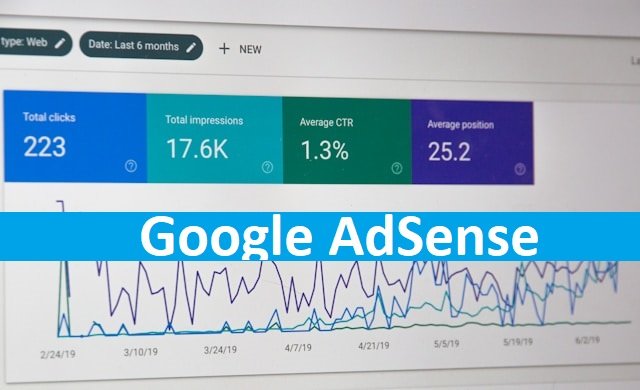
Google AdSense is a popular advertising program that allows website owners to monetize their content by displaying ads on their site. Launched in 2003, the program has become a go-to choice for many website owners looking to earn revenue from their online content.
AdSense works by connecting website owners with millions of advertisers who are looking to promote their products or services online. By displaying these ads on their site, website owners can earn money based on user clicks or impressions. AdSense offers a variety of ad formats, including display ads, text ads, and link units, giving website owners flexibility in how they choose to display ads on their site.
To get started with AdSense, website owners need to sign up for an account and add the AdSense code to their website. From there, they can customize the types of ads they want to display and track their earnings through the AdSense dashboard. With its ease of use and potential for generating revenue, it’s no wonder that Google AdSense has become a popular choice for website owners looking to monetize their online content.
Getting Started with Google AdSense
Eligibility Requirements
To be eligible for Google AdSense, a website must meet certain criteria. The website must have original content, be compliant with Google’s policies, and receive a significant amount of traffic. Additionally, the website must not contain any prohibited content, such as adult content, violent content, or copyrighted material. Websites that meet these requirements can apply to join the AdSense program.
Sign-Up Process
The sign-up process for AdSense is straightforward. First, the website owner must create an AdSense account by providing basic information about themselves and their website. Then, they must add AdSense code to their website to allow Google to display ads. Once the code is added, Google will review the website to ensure it meets the eligibility requirements. If approved, the website owner can start earning revenue from AdSense ads.
AdSense Account Structure
AdSense accounts are structured into three levels: the account level, the ad unit level, and the ad level. The account level includes all of the website owner’s AdSense settings and reports. The ad unit level includes the specific ad units that are placed on the website. The ad level includes the individual ads that are displayed within the ad unit. Website owners can customize their AdSense account at each level to optimize their revenue and ensure that the ads displayed on their website are relevant to their audience.
In summary, Google AdSense is a program that allows website owners to monetize their website by displaying ads. To get started, website owners must meet the eligibility requirements, complete the sign-up process, and customize their AdSense account settings.
Implementing AdSense on Your Website
There are a few key steps you need to follow to implement AdSense on your website. These include creating ad units, customizing the look and feel of your ads, and following best practices for layout.
Ad Units and Placement
Ad units are the building blocks of AdSense. They come in a variety of sizes and formats and can be placed in different locations on your website. To create ad units, simply log in to your AdSense account and follow the prompts.
Once you have created your ad units, it’s important to place them in the right locations on your website. AdSense provides several tools, including heat maps and ad balance reports, to help you determine the best placement for your ads.
Customization and Styles
Customizing the look and feel of your ads is an important part of making them blend seamlessly with your website. AdSense provides a number of customization options, including font styles, colors, and ad borders.
It’s important to strike a balance between making your ads stand out and making them blend in with your website. Experiment with different styles and colors to find the right balance for your website.
Best Practices for Layout
Following best practices for layout is key to maximizing your AdSense earnings. Some tips to keep in mind include:
- Placing ads above the fold
- Using responsive ad units
- Avoiding too many ads on a single page
- Using text and display ads together
By following these best practices, you can ensure that your AdSense ads are seen by your visitors and are optimized for maximum revenue.
Understanding AdSense Policies
Google AdSense is a program that allows publishers to monetize their website by displaying targeted ads. However, to ensure the quality of the ads and maintain a positive user experience, AdSense has a set of policies that all publishers must follow. In this section, we will discuss the two main AdSense policy categories: Content Guidelines and Click Fraud Prevention.
Content Guidelines
AdSense has strict policies regarding the content that is allowed to be monetized. Publishers must ensure that their website content adheres to these guidelines, or risk having their AdSense account disabled. Some of the key content guidelines include:
- Prohibited content: Publishers are not allowed to monetize content that contains adult themes, violence, hate speech, or illegal activities.
- Copyrighted material: Publishers cannot monetize content that infringes on someone else’s intellectual property rights.
- Misleading content: Publishers cannot monetize content that contains false or misleading information.
- User-generated content: Publishers are responsible for ensuring that user-generated content on their website also adheres to AdSense policies.
To ensure compliance with these guidelines, publishers should review the AdSense program policies regularly and ensure that their website content meets the standards.
Click Fraud Prevention
Click fraud is a major concern in the digital advertising industry. AdSense has policies in place to prevent click fraud and ensure that advertisers are getting what they pay for. Some of the key click fraud prevention policies include:
- Invalid clicks: Publishers cannot click on their own ads or encourage others to do so. AdSense has systems in place to detect invalid clicks and will take action against publishers who engage in click fraud.
- Traffic sources: Publishers cannot use artificial means to generate traffic to their website, such as buying traffic or using bots.
- Ad placement: Publishers must ensure that ad placement on their website is compliant with AdSense policies. For example, ads cannot be placed in a way that encourages accidental clicks.
Publishers should review the AdSense program policies regularly and monitor their website traffic and ad placement to ensure compliance with these policies.
In summary, AdSense policies are in place to ensure the quality of ads and maintain a positive user experience. Publishers must adhere to these policies to continue monetizing their website with AdSense. By following the content guidelines and click fraud prevention policies, publishers can help ensure the long-term success of the AdSense program.
Monitoring and Reporting
Google AdSense provides comprehensive monitoring and reporting features to help publishers keep track of their account performance. In this section, we will discuss two important subsections of monitoring and reporting: Performance Reports and Analytics Integration.
Performance Reports
Performance reports provide publishers with insights into their account performance. These reports include charts and tables that allow publishers to view trends, compare important metrics, and quickly check their earnings. AdSense offers pre-made Performance Overview reports that display an overview of the earnings for the selected date range.
Publishers can also create, save, and schedule custom reports to help them keep track of how things change over time. Custom reports can be created by selecting the desired dimensions and metrics, and then applying filters to the data.
Analytics Integration
Google AdSense can be integrated with Google Analytics to provide publishers with more detailed insights into their website’s traffic and user behavior. By integrating AdSense with Analytics, publishers can track their AdSense earnings and performance alongside their website’s traffic and user behavior.
The integration allows publishers to view AdSense data in Analytics reports, such as the Audience, Acquisition, and Behavior reports. This integration provides publishers with a more comprehensive view of their website’s performance, allowing them to make more informed decisions about their website and AdSense strategy.
In conclusion, monitoring and reporting are essential aspects of managing a Google AdSense account. Performance reports and analytics integration provide publishers with valuable insights into their account performance and website’s traffic and user behavior. By regularly monitoring and analyzing this data, publishers can optimize their AdSense strategy and maximize their earnings.
Maximizing AdSense Revenue
Google AdSense is a powerful tool that allows website owners to generate revenue by displaying ads on their website. However, simply signing up for AdSense and placing ads on your website is not enough to maximize your earnings. In this section, we will explore some techniques that can help you optimize your AdSense revenue.
SEO and Traffic Generation
One of the most important factors that affect AdSense revenue is the amount of traffic your website receives. The more traffic your website receives, the more potential ad impressions you will have, which can lead to higher earnings. Therefore, it is essential to focus on search engine optimization (SEO) and traffic generation techniques to drive more visitors to your website.
Some effective SEO techniques include optimizing your website’s content for relevant keywords, building high-quality backlinks, and ensuring your website is mobile-friendly. Additionally, you can use social media marketing, email marketing, and other digital marketing techniques to drive traffic to your website.
Ad Optimization Techniques
Another critical factor that affects AdSense revenue is ad optimization. Ad optimization involves optimizing the placement, size, and type of ads on your website to maximize clicks and revenue. Here are some effective ad optimization techniques:
- Experiment with ad placement: Try different ad placements on your website, such as above the fold, in the sidebar, or at the end of content. Use Google AdSense metrics to track the performance of different ad placements and adjust accordingly for optimal results.
- Use responsive ad units: Use responsive ad units that adjust to the size of the user’s screen. This ensures that your ads look good and are visible on all devices.
- Make your ads more visible: Reduce page length, place ads right above the fold, and use large ad sizes to increase the number of viewable ad impressions on your site.
- Focus on high-paying ads: Use Google AdSense’s ad review center to block low-paying ads and focus on high-paying ads that generate more revenue.
By implementing these techniques, you can optimize your AdSense revenue and generate more income from your website.
Frequently Asked Questions
How can I set up a Google AdSense account for my website?
Setting up a Google AdSense account is a straightforward process. First, you need to have a website or a YouTube channel that meets Google’s eligibility criteria. Then, you can sign up for AdSense and submit your application for review. Once your application is approved, you can create ad units and place them on your website or YouTube channel.
What are the requirements to be eligible for Google AdSense?
To be eligible for Google AdSense, your website or YouTube channel needs to meet certain requirements. For example, it should have original content, comply with Google’s program policies, and receive a sufficient amount of traffic. Additionally, you need to be at least 18 years old and have a valid mailing address.
How are payments calculated and distributed by Google AdSense?
Google AdSense calculates payments based on a combination of factors, such as the number of clicks on your ads, the cost-per-click of the ads, and the number of impressions. Payments are distributed on a monthly basis, typically around the 21st of each month. You can choose to receive payments via various methods, such as direct deposit, wire transfer, or check.
What is the process for integrating Google AdSense with YouTube?
If you have a YouTube channel, you can monetize your videos by enabling ads through Google AdSense. To do so, you need to meet YouTube’s eligibility criteria, such as having at least 1,000 subscribers and 4,000 watch hours in the past 12 months. Then, you can link your YouTube channel to your AdSense account and enable monetization for your videos.
How can I troubleshoot issues with Google AdSense payments?
If you encounter issues with Google AdSense payments, there are several steps you can take to troubleshoot them. For example, you can check your payment settings to ensure that they are accurate and up-to-date. You can also review your payment history to see if there are any discrepancies or issues that need to be resolved. Additionally, you can contact AdSense support for further assistance.
What strategies can increase earnings from Google AdSense?
There are several strategies you can use to increase your earnings from Google AdSense. For example, you can optimize your ad placement and format to maximize clicks and impressions. You can also experiment with different ad sizes and types to see which ones perform best. Additionally, you can focus on creating high-quality, engaging content that attracts and retains visitors to your website or YouTube channel.




